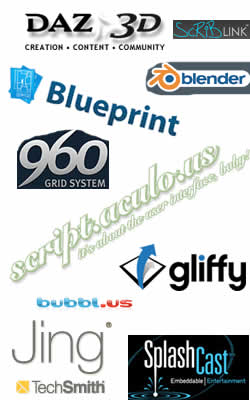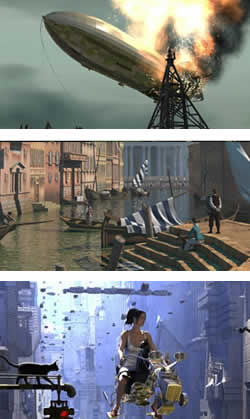Sent to you by bodyartist via Google Reader:

So, you're set to wow the world with your visual design skills. But after you've paid for your college classes and books, there's not much left over for software – unless you sacrifice your *ahem* study sessions at The Keg. Well no need to sacrifice. There's a ton of free and Open Source software that you can use for art and design, and much of it rivals paid software. Here is a suggested tool kit. Where possible, we've tried to suggest multi-platform (Mac, Windows, Linux) apps. Apps are arranged into 15 categories.
1. 2D vector. Adobe Illustrator might be nice but it's also expensive. Inkscape offers many of the same features, plus a few extras. If you simply need something to draw diagrams with, consider the web-based Gliffy.
2. 2D raster. Photoshop and its cousins might rule the paid territory for graphics editors, though the free, Open Source GIMP does quite well itself, thank you very much. While it might be a bit awkward in interface if you're used to Photoshop, regular use will cure you of that. If you still miss the Photoshop interface, try the GIMPshop modification. 3. 3D vector. Often overlooked in this category is POV-Ray, a "ray tracing" program that is capable of producing amazing photorealstic scenes. There are also a number of advanced 3D modelling plugins for POV-Ray, as well as some modified versions released by third parties under different application names.

Bryce (MS Windows), which is usually a paid option, is sometimes released for free online in older versions. If POV-Ray's code-driven interface isn't your thing, you'll enjoy Bryce's visual interface. Get Bryce 5.5 at Download.com. 4. Collaboration. Got a project that you have to collaborate on with one or more fellow students? Campfire (free and paid versions) lets you have online meetings. In addition to Instant Messaging, you can share images, code and other files in real-time and discuss them. Another option, using a different paradigm, is Scriblink, which is a "digital whiteboard." It offers in-screen chat and VoIP conferencing in the web application itself, as well as file transfer. 5. Design brainstorming. Whether you collaborate with teammates or work on your own, brainstorming designs or sketch ideas gives produces options without stress. Mind mapping applications are ideal for brainstorming, and you can even attach image snaps to map nodes for comparison. Mind mapping apps come in two flavors, desktop and web-based, and come in free and paid versions. Top of the line in the free category are FreeMind, XMind and basic versions of bubbl.us, Mindomo, and Mindmeister, amonst others. (The latter two have free and paid versions.) 6. Modeling and animation. Both POV-Ray and Bryce, listed above, have animation features, but Blender is simply designed for 3D animation. Alternatively, DAZ 3D, who offer the aforementioned Bryce, also offer the free DAZ Studio, which is more comparable to Blender. DAZ Studio integrates well with Poser, for producing animated human models. 7. CSS templates and blog themes. A number of the most popular blogging themes (particularly for WordPress) are inspired by free CSS templates available at Open Source Web Design, Open Web Design, and Open Design Community, amongst others. Their license use allows you to tweak templates found there and share with others, so you can create blog themes out of the CSS templates as well. 8. Web page layout and design tools. There are far too many apps in this broad category, but here are a couple.
- Web page grid framework libraries. It's fine to use CSS templates, but sometimes you need a unique page design. Save yourself some design time using one of the several "grid framework" options, including Blueprint and it's spawn 960.
- NVU. NVU is a free, multi-OS web page layout/ design environment that's comparable to FrontPage and Dreamweaver.
9. Web page scripting tools. Page design is great, but if you need a website that does more than look pretty, you'll want to implement various types of user interactivity. One of the most powerful yet time-saving ways to do this is to use a JavaScript library such as jQuery, Prototype or Script.aculo.us. Also check the Javascript Libraries website for a list of other options. 10. Photo hosting/ sharing. There are probably dozens of photo/ image hosting and sharing sites available. While Photobucket is probably one of the most popular, Flickr arguably has more of a community base and more social features. Both are free, though Flickr does offer a pro version. 11. Presentations. Do you have a project presentation in MS PowerPoint or similar form? If you want to share online, SlideShare is one of several options. It even allows for clickable hyperlinks from within the embedded player, so you can even turn your presentation content into lessons. 12. Video tools. If you get the desire to produce a screencast video demonstrating some of your art or design techniques, look to Camstudio, which is an entirely free, Open Source alternative to the powerful but relatively expensive TechSmith Camtasia Studio. Note that TechSmith does have the free JingProject, which combines a desktop app with online storage. For additional free (and paid) screencasting options, please see Mashable, Just Skins, Digital Inspiration, Wikipedia, and Coding Horror. 13. Video sharing sites. Once you've produced your screencasts or design reels, you're going to need somewhere to host them. While YouTube does in a pinch and is a popular site, SplashCast offers an arguably superior interface and embeddable media player. If you do want to take advantage of multiple video sharing sites, try TubeMogul for simultaneous upload. 14. Web browser. Today's design and art students probably can't get through college without being online, even just for research. A good browser with extra features goes a long way. If you're designing web logos or pages, you'll also to have the option of adding whatever plugins will help you in your work. Mozilla Firefox. Not only is Firefox one of the most popular web browsers, it has hundreds of addons (plugins) – many of which are suitable for web design and development. Some Firefox addons of interest:
- MeasureIt. For web page design, to measure distances/ areas in pixels.
- Web Developer. A whole suite of tools for web page development, but also handy for page design.
Google Chrome is being touted as an alternative to Mozilla Firefox, though it has a ways to go have all the power of the latter. 15. Web publishing. Do you need to publish your portfolio online, or want to show off your content with others? There are at least a half-dozen website/ blog publishing options, if not more. Here are two of the most popular, for self-hosted blogs and websites.
- WordPress. WordPress isn't just for blogs. It can be used as a low-end CMS (Content Management System), and with a few plugins or some custom tweaking, it can make for a great online gallery or portfolio for your visual work.
- Drupal. Drupal is in many ways more powerful than WordPress, but installing and configuring it might require a bit more technical expertise than for WordPress. If it's worth it to you, it has "online community" features out of the box, whereas WP requires using additional software and plugins, particularly WordPress Multi-User and BuddyPress, combined, or one of the various online forum apps (e.g., BBPress or Vanilla).
Things you can do from here:
- Subscribe to Online College Tips - Online Colleges using Google Reader
- Get started using Google Reader to easily keep up with all your favorite sites
































































.jpg)









No comments:
Post a Comment